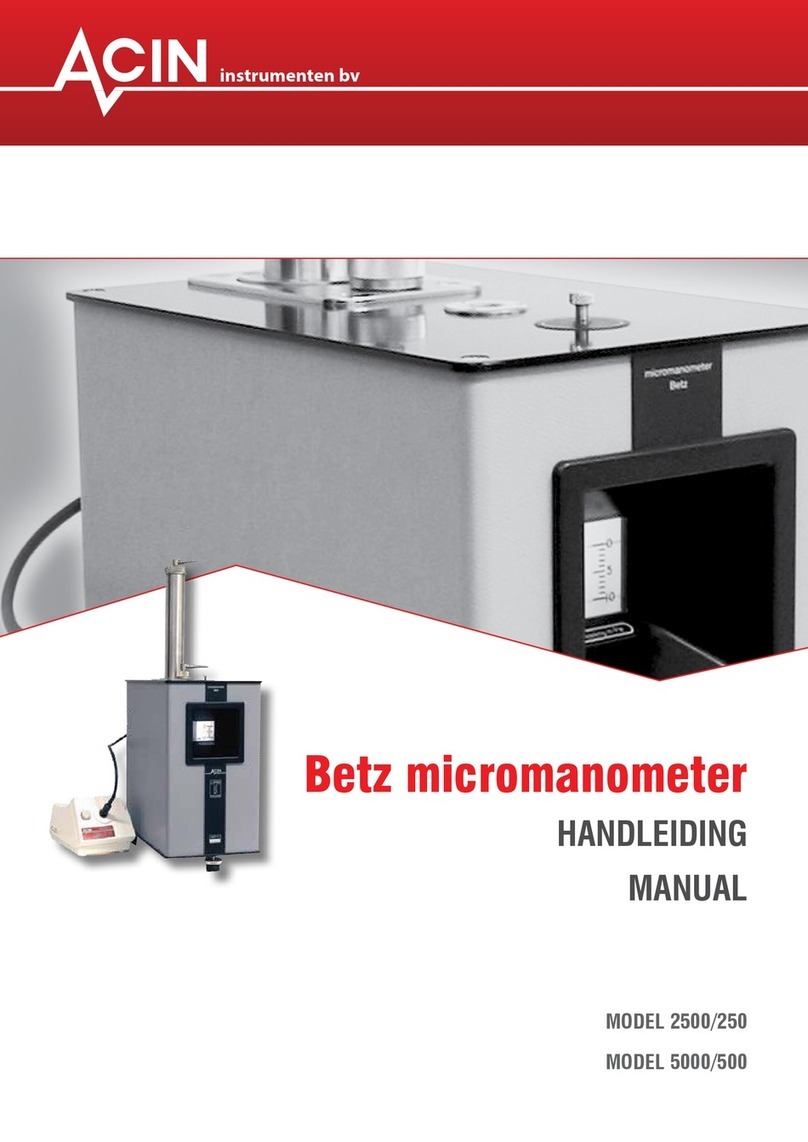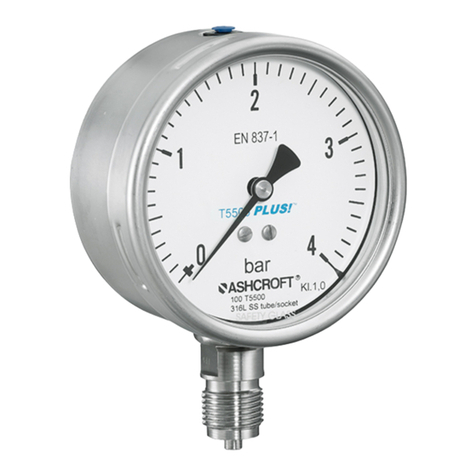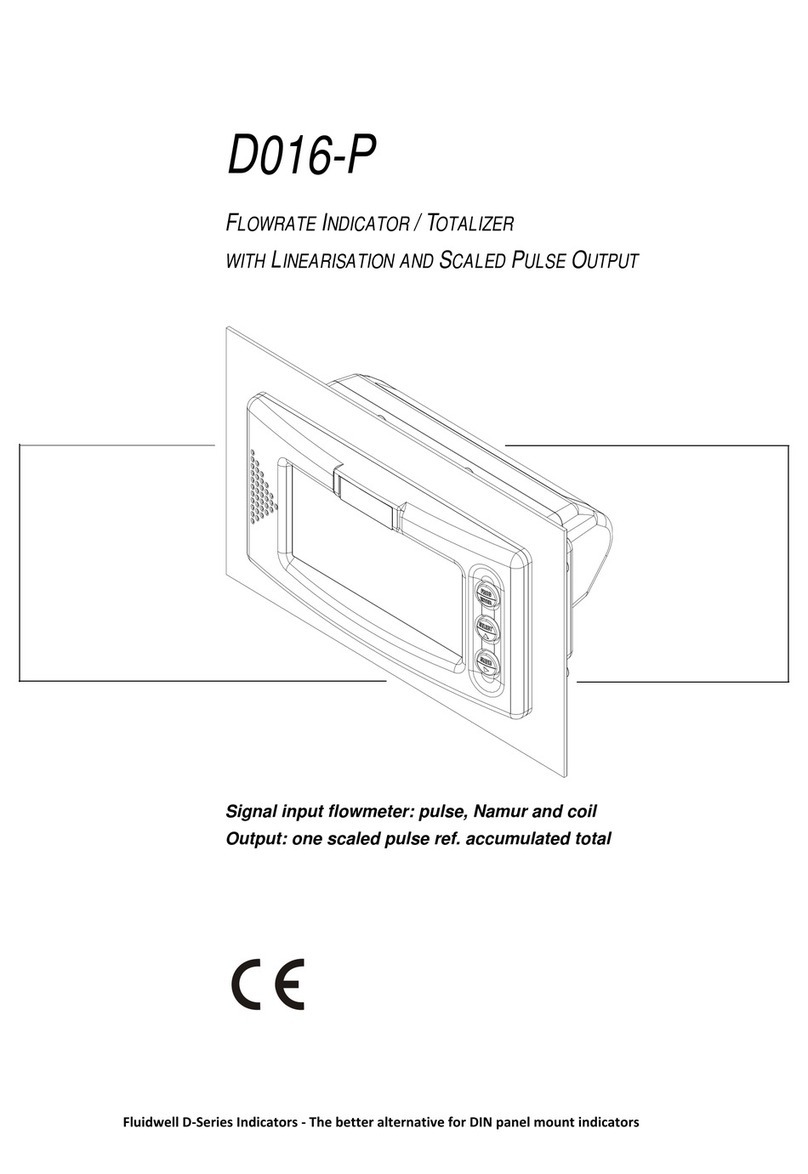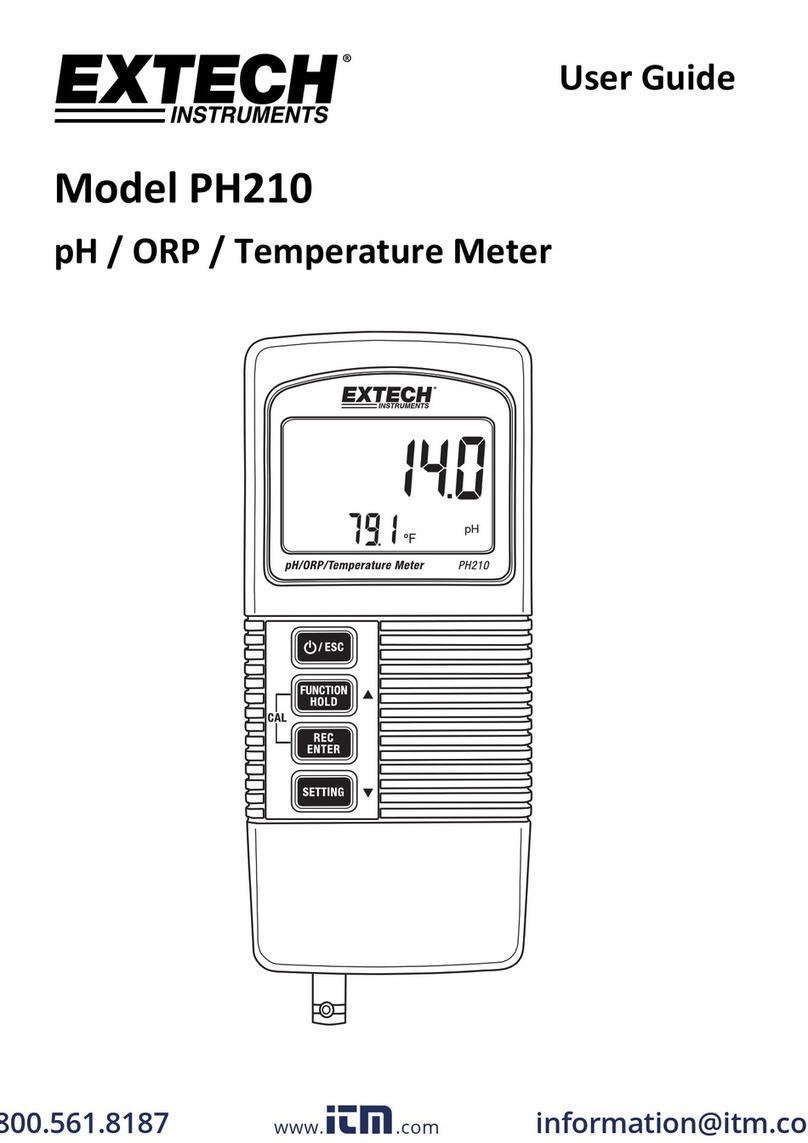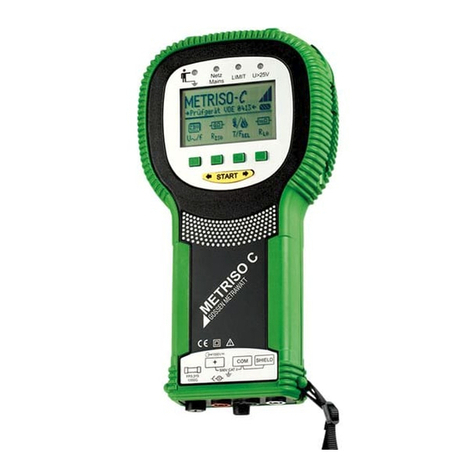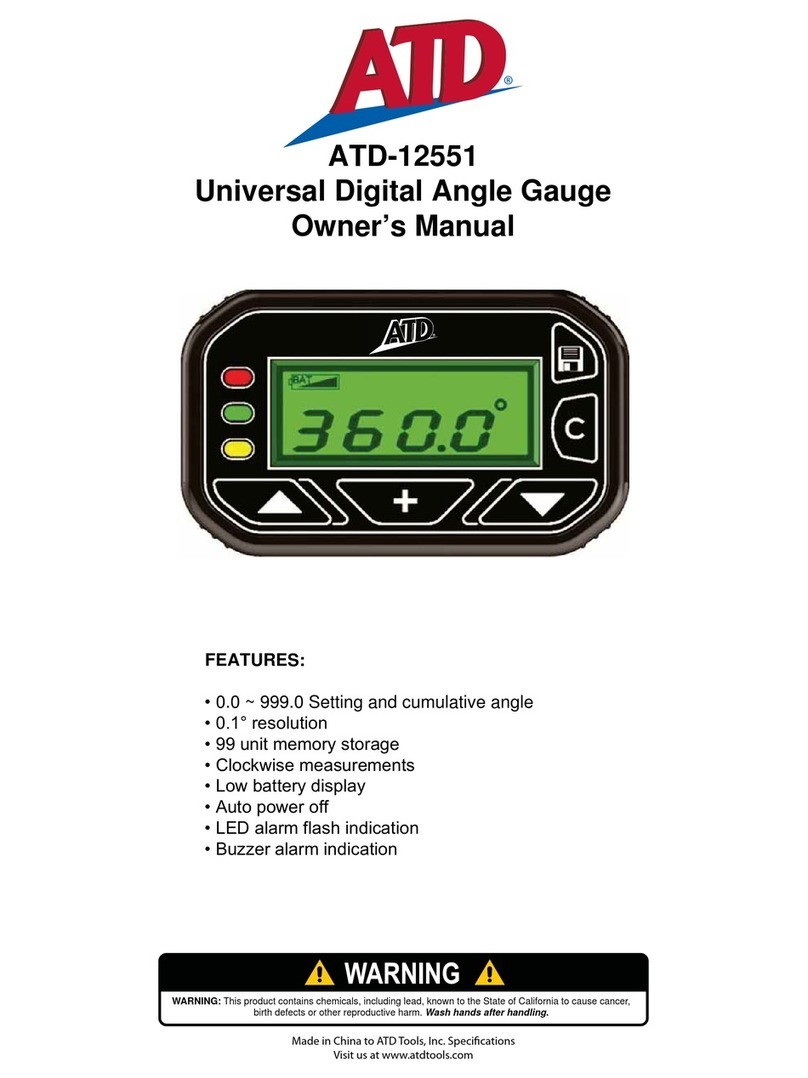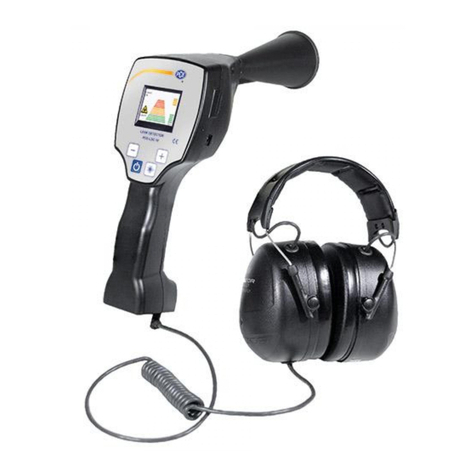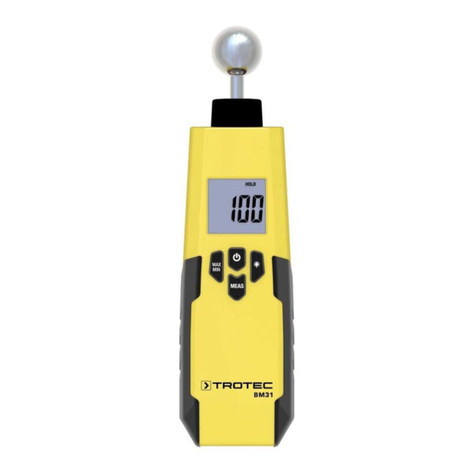Sicame Nortroll Dragon LineTroll 110Em User manual

30.09.2020
LINETROLL 110E/110Eµr User Guide May2014 Page 1 of16
LineTroll110Eµ
LineTroll110Eµr
Remote Indicator System - RIS
“Dragon”
User Manual

LINETROLL 110E/110Eµr User Guide May 2014 Page 2 of 16
TABLE OF CONTENTS
1. LINETROLL 110E/110EµR OVERVIEW...................................................................3
2. FUNCTIONAL DESCRIPTION......................................................................................3
2.1. Sensors......................................................................................................................... 4
2.2. Activation criteria....................................................................................................... 4
2.3. Indication..................................................................................................................... 4
2.4. Reset criteria ............................................................................................................... 4
2.5. Battery lifetime / maintenance .................................................................................. 5
2.6. Low battery warning.................................................................................................. 5
2.7. Low battery warning reset......................................................................................... 5
2.8. Fault sensitivity........................................................................................................... 5
3. APPLICATION..................................................................................................................6
4. APPLICATION NOTES...................................................................................................7
4.1. Energising a healthy line............................................................................................ 7
4.2. Connecting a faulty line while the indicator is activated ........................................ 7
4.3. Transient fault ............................................................................................................ 8
4.4. Fused lines................................................................................................................... 8
4.5. Multiple faults............................................................................................................. 8
4.6. Capacitive discharges................................................................................................. 9
4.7. PROGRAMMING.................................................................................................... 10
4.7.1. Di/dt sensing ........................................................................................................... 10
4.7.2. Threshold sensing ................................................................................................... 10
4.7.3. Start/Stop criteria .................................................................................................... 10
4.7.4. Timer reset .............................................................................................................. 10
4.7.5. Auto-Reset .............................................................................................................. 10
4.7.6. Programming of radio addresses............................................................................. 11
5. MAINTENANCE.............................................................................................................11
5.1. Battery replacement ................................................................................................. 11
5.2. Reset battery monitoring ......................................................................................... 11
6. INDICATOR HOUSING.................................................................................................11
7. TECHNICAL SPECIFICATIONS................................................................................12
8. DIMENSIONS.................................................................................................................13
9. MOUNTING.....................................................................................................................13
10. FLASHING SEQUENCES:...........................................................................................15
Terms:
Energised line: Voltage or current present
De-energised line: Voltage or current not present
LT: LineTroll
RIS: Remote Indication System
Ordering info:
Prod.no.: Product:
04-1200-05: LT-110Eµ newline clamp & super intensityred LED “Dragon”
04-1200-06: LT-110Eµr with radio & new line-clamp& super int LED “Dragon”
04-1200-26: LT-110Eur with radio & communication-SW for LT-R110C-RIS

LINETROLL 110E/110Eµr User Guide May 2014 Page 3 of 16
1. LINETROLL 110E/110Eµr
OVERVIEW
LINETROLL 110E(110E) is a line
mounted fault indicator for local
indication.
LINETROLL 110Er(110Er) has the
same functionality as the 110Eu but has an
integrated radio that communicate with a
pole-mounted device named Collector
(CmT-110C, -115C, LineTroll R110C or
others) that can be interfaced to a SCADA-
RTU or a communication device by means
of dry relay contactsor serial-port for
remote indication of faults.
Unless especially mentioned, all the
following information is valid forboth
110Eµ and 110Eµr.
It is a single phase unit, but as they
normally are used in groups of 3, to fully
cover different fault configurations that
may occur, they are delivered as kit of
3 units each package.
It is a Fault Passage Indicator;detects
down-streams fault in OH-distribution
network; short circuit and earth fault if the
networkprovide sufficient earth fault
current.
The indicators are placed at strategic
locations along the line such as after
branching points and sectionalisers. It
mounts directly on the high voltage
conductor.
Live line mounting is easily and rapidly
done with a grip-all clamp Hot-Stick.
Upon fault sensing, all indicators installed
in the faulty phase(s) between the feeding
substation and the fault will operate. The
indicators placed behind the fault or in the
non-damaged phase(s) remain idle.
Upon detecting a fault on theline, the
indication by means of an intermittent red
LED- flash forpermanent fault and a green
LED for a transient faults.
The lens of the indicatorallows for
uniform 360 degreesmonitoring.
LINETROLL 110Erprovides fast fault
location enabling reductionin outage
times. This represents enhanced service to
the customers thereby improving the
utilities image.
Anotherimportant aspect of using fault
indicators is that unnecessary operations of
circuit breakers and sectionalisers to locate
the fault are avoided. This waythe
indicators help reducewear and tear as
reclosing cycle causes stress to the
switchgear.
2. FUNCTIONAL
DESCRIPTION
LINETROLL 110Econtinuously
monitors the line voltage and phase
current, the sources of information it needs
to operate. The unit is fully self contained,
no external transformers or connections are
required.
During normal line conditions; the 110E
does not flash.
The indicator is looking for a specific
sequence of line conditions to happen
before it starts indicating locally and
remotely. The general sequence is as
follows:
A. The line should be energised (voltage
or current present) for at least 5
seconds.
B. The line current should increase
instantaneously by the amount of a user
set value (the step level), or exceed a
threshold value.
C. The line should be de-energised.
voltage or current not present
However, theuser might program the
conditions for operation to suit his local
requirement by manipulating a bank of
micro-switches inside the indicator.
Note: Voltage or current as start and
stop criteria are user programmable.

LINETROLL 110E/110Eµr User Guide May 2014 Page 4 of 16
2.1. Sensors
The magnetic field generated by the line
current induces a signal in the indicator
pickup coil. The induced signal is applied
to a di/dt sensor in order to discriminate
between fault current and load current.
The di/dt sensor detects instant current in-
creases as is the case when faults occur.
The trip level of the di/dt can be set to 6,
12, 25, 60A or 120A by means of a switch
bank inside the unit.
A normal variation of the load current will
not activate LINETROLL 110E.
Figure 1: Magnetic field sensor principle.
Figure 2: Electric field sensor principle
The line voltage is detected by means of an
aerial placed inside the indicator.
2.2. Activation criteria
LINETROLL 110Ecan be easily set to
operate in the wanted mode by altering a
number of switches inside the unit.
In order to avoid activating the indicator
due to the magnetising inrush current of
the line, it's di/dt sensor is blocked for 5
sec. upon re-energising of the line. While
the blocking time elapses, the line current
stabilises and doesnot cause triggering of
the di/dt sensor.
A fault duration exceeding 60ms is
required to activate the indicator.
In addition to its di/dt sensor,
LINETROLL 110Eincorporates a
common threshold sensor with threshold
levels of 250, 500A or 750A. The
threshold criterion, if enabled, activates the
indicator if the fault current exceeds the
selected level. (The inrush blocking is still
active in this mode)
A rapid line current increase followed by a
de-energising of the line within 5 sec. will
activate the indicator.
It can also be set to indicate upon a rapid
current increase without looking fora de-
energised line.
2.3. Indication
The main indication; A super intensive red
LED indicates permanent faults. The
secondary indication is a single green
LED.
•Transient fault: Only the green
LED flashes for24h.
•Permanent fault: The red LED *)
flash until reset (timer-, auto- or
manual-reset).
*) Note: to verify a permanent fault, the
red Indicationis delayed 70 sec. See more
detailed info Ch 10 Flashing sequence.
2.4. Reset criteria
The indicator automatically resets in two
different ways:
1) When the line is energised. The voltage
or current sensor detects that the line is

LINETROLL 110E/110Eµr User Guide May 2014 Page 5 of 16
energised and can in turn reset the
indicator after30 seconds of
continuously energised line
2) Automatic reset by internal timer.
This timer can be set to:
2, 6, 12 or 24 hours
The indicator can also be reset manually at
any time by use of a magnet, or by use of
the mounting and testing tool KBN-4.
2.5. Battery lifetime / maintenance
A 3,6V 16,5 Ah Lithium battery powers
the indicator. When idle, the 110Eµ
consumption is a few micro-Amps only,
giving some 9-10 years battery lifetime in
normal service. For the 110Eµr it is
recommended to replace battery after7-10
years due to the additionalpower
consumption forthe radio.
When the unit is activated, approximately
4 mA are consumed, giving more than
1500 hours of flashing capacity. The
battery is fitted with a connector for simple
replacement.
Figure 3: Initial battery capacity.
Figure 4: Remaining battery capacity as a
function of years and temperature
2.6. Low battery warning
During the last few months of the battery’s
life, a yellow LED with a low flashing
frequency will indicate that less than 20%
of capacity remains and that there is a need
for battery replacement.
The 110Eµr will in addition send a
message “Low battery” to the Collector.
2.7. Low battery warning reset
In the case of batteryreplacement the
batterycapacity monitoring must be reset.
See Ch 5.2.
2.8. Fault sensitivity
The indicator’s di/dt sensitivity is limited
by the load current.
See table in Ch. 7. TECHNICAL
SPECIFICATIONS.
The indicator detects short-circuit- as well
as earth-faults provided the di/dt current
change exceeds the detectionlevel or
absolute threshold level dependent on
programming.

LINETROLL 110E/110Eµr User Guide May 2014 Page 6 of 16
3. APPLICATION
The application of LINETROLL 110Eµ
usually requires a previous line survey so
that the best use of it may be obtained.
For the best economic benefit it is recom-
mended that the indicators are used:
•
In easily accessibly line points for easy
monitoring of the indicator in case of
fault, for instance near the road. It is
advisable to take binoculars.
•
Before and afterline points difficult to
reach (mountains, woods, etc.)to
quickly locate the fault.
•
Next to line branching points, to easily
locate the damaged branch.
When installing indicators at such
points, the use of indicators in every
branch is recommended in order to
provide complete information in the
event of fault. Not doing so may cause
confusion since there may be an
indication in a branch due to a non-
permanent fault while another branch
without indicator may be faulty yet
considered healthy.
•
Near line points with sectionalisers to
rapidly pinpoint and isolate thefault to
facilitate rapid reconnection the healthy
sections.
LINETROLL-110Er issuitable in:
•
6-132kV Distribution networks
including SWER-lines. (see Note)
•
Radial lines.
•
Multiple circuit lines (Current reset
must be used)
•
Solidly-earthed-neutral networks.
•
Compensated and impedance-earthed-
neutral networks. If indication of earth-
faults are required, the indicators
sensitivity and the networks residual
fault current has to be taken into
account.
•
On conductors of 5-36 mm diameter.
with special emphasis on:
•
Areas with unpredictable electro-
magnetic fields caused forexample by
parallel lines, as a bettersuited
complement to the three-phase fault
indicator LINETROLL 111K.
Do not use LINETROLL 110Eron:
•
Ring lines or multiple fed lines.
Importantnotice:
Using the LineTroll 110E/Er on voltage
levels from 66kV to 132kV requires a
corona trap as shown on the picture below.
The corona trap can be mounted in factory
upon specification in the order or mounted
by the user.

LINETROLL 110E/110Eµr User Guide May 2014 Page 7 of 16
4. APPLICATION NOTES
The aim of this section is to describe how
the LINETROLL 110Eindicatorbehaves
in different service situations and network
events.
4.1. Energising a healthy line
As the magnetising inrush current of a line
can be very high, the indicator is provided
with a 5 secondsblocking which prevents
it from being activated until the line
current is stabilised. Once the blocking
time has elapsed, the indicator is enabled
for fault detection.
See Figure 5.
.
Figure 5: Criterion of the blocking time.
a) shows the sequence when a fault occurs less
than 5 sec afterline has been energised:
→No Indication.
If, upon re-energising of the line, the unit is
indicating due to a previous fault, the unit
will reset if the voltage- or current reset
option is enabled, but even in this case the
indicator will flash for 30 seconds
(dependingon the programming, see 4.7)
before finally extinguishing. See Figure 6.
Figure 6: Delayed reset of flashing.
4.2. Connecting a faulty line while the
indicator is activated
Closing a breaker onto a fault leads to
another trip almost instantly.
As the activated indicator needs30 seconds
with the line energised in order to reset, it
will continue indicating.
See Figure 7.
Figure 7: Reclosing upon a faulted line.

LINETROLL 110E/110Eµr User Guide May 2014 Page 8 of 16
4.3. Transient fault
Transient fault cleared within thelast
automatic reclosing, will be detected by the
green LED. The LED will flash for24
hours as extended transient indication.
If a new fault occurs withintimeout (24h),
the indicatorwill reset the green LED and
indicate forthe new fault.
4.4. Fused lines
One operation criterion (assuming
automatic voltage reset is enabled) is that,
aftera fault, three-phase disconnection of
the line has to be carried out. If, instead of
a three-phase trip, a fuse operates in one or
two phases, the voltage of the healthy
phase(s) may cause no indication or reset
of indication.
This is true for indicators placed beforethe
fuse as well as afterit.
When the criterion of automatic voltage
reset is enabled, LINETROLL-110Eris
not activated unless the fault causes a
three-phase trip in the feeding within 5
seconds afterthe occurrence of the fault.
If there is one disconnection within 5 sec,
followed by an automatic reclosing causing
a fuse-operation, the indication starts, but
will reset after30 sec.
If the automatic reset is switched off, the
indicator will continue flashing until it is
reset manually or afterthe automatic timer
period has elapsed.
4.5. Multiple faults
Multiple faults sometimes occur. Defective
networkcomponents may burn or break
due to the electro-dynamic force of the
fault current and cause a second fault.
Anothercause of multiple faults is the
increase in the phase to ground voltage on
the healthy phases due to the initial earth
fault.
The phase to ground voltage may reach up
to 1.7 times the nominal voltage,
dependingon the total impedance of the
earth loop. If there are weakpoints in the
line, they may not withstand such a large
voltage increase. This type of fault may be
difficult to find as they often are non-
permanent and only appear in situations
like the ones mentioned here.
Note: In this situation the indicators
may show non-consequent indication.
<5s
Line
I
Indication
24h
Extendedtransient fault
indication
Green
LED

LINETROLL 110E/110Eµr User Guide May 2014 Page 9 of 16
4.6. Capacitive discharges
The LINETROLL-110Erindicatoris not
directional, it therefore detects current
without discriminating its direction. In case
of an earth fault, the network capacitive
energy discharges in the fault point. It
should be checked that the capacitive
discharge current downstreamtheindicator
is below preset trip level in order to avoid
the indicatorerroneously activating upon
earth faults.
If the total capacitive current exceeds the
trip level, it is advisable to change the trip
level or install the indicators in the
branching points instead of in the main
line. The capacitive discharge of a
branching point is limited by its own
capacitance, while in the main line the
capacitive current of all the branches
downstreamthe indicator is added.
Underground cables have larger
capacitance than overhead lines. This has
to be takeninto account when an overhead
line feeds an underground cable.
The following simplified formula may be
used to estimate the capacitive discharge
current of a line:
Ic = U * La + U * Lc
300 K
Ic = Capacitive current in A
U = Nominal voltagein kV
La = Overhead line length in km
Lc = Cablelength in km
K = 10; for oil impregnated
cables
5; for PEX cables
3; for PVC cables
In order to avoid that the LINETROLL-
110Er is activated by an earth fault
upstream the indicator, the following
criterion has to be met.
Ic < It
where
Ic = capacitive current downstream
the indicator.
It = Setting of sensitivity (6 –120A)
To estimate the capacitive discharge
current at any line point, you have to
calculate the contribution from all the
overhead lines and underground cables
lengths only beyond that point.
Figure 8: Capacitive discharge current
calculation example

LINETROLL 110E/110Eµr User Guide May 2014 Page 10 of 16
4.7. PROGRAMMING
The indicator has two options for
programming;
1. Local by manipulating the
microswitches on the PCB.
Figure 9: Close-up of switch-banks.
2. Remotely from the Collector
CmT115C or LineTroll R110C
The latter option opens for a re-
programming from ground afterthe
indicator is mounted on theline, assuming
that sw8=ON (=Remote programming)
NOTE: Before doing any settings, decide
if the indicator should be ready forremote
or local programming.
Sw 8
Programming
0
Local
1
Remote from CmT115C
Table 1: Local/Remote programming
4.7.1. Di/dt sensing
Switch #
Di/dt Current level
1
2
3
0
0
0
6 A
0
0
1
12 A
0
1
0
25 A
0
1
1
60 A
1
1
1
120 A
Table 1: Di/dt setting
4.7.2. Threshold sensing
Switch #
Threshold level
1
2
3
1
0
0
250 A
1
0
1
500 A
1
1
0
750 A
Table 2: Threshold setting
4.7.3. Timer reset
Sw #
Timer reset
5
6
0
0
2 hours
0
1
6 hours
1
0
12 hours
1
1
24 hours
Table 3: Timer reset
4.7.4. Start/Stop criteria
Sw 4
Start/Stop criteria
0
Current
1
Voltage
Table 4: Start/Stop criteria.
4.7.5. Auto-Reset
Programming of the automatic reset (AR)
of indication when line has been energised
for more than 30 sec (voltage or current).
Sw 7
Auto Reset on return of
Voltage/Current
0
OFF * No auto-reset on re-
energising
1
Reset on return of Voltage or
Current depends on sw 4 (see
above)
Table 5: Auto-Reset
*) Note: The CB-tripping conditions is
fixed and do not depend on Sw#7.
Note:
To enable new switch-settings, a
RESET of the indicator is required;
reconnection of the battery or a magnet
at the RESET-spot.

LINETROLL 110E/110Eµr User Guide May 2014 Page 11 of 16
4.7.6. Programming of radio addresses
All indicators in the same location must be
given a unique ID’s by rotating the address
selector.
It is recommened to give indicators on the
same line/feeder ID= 1, 2 and 3, and
indicators on the next feeder(in same
location) 4,5 and 6... etc.
For setting up a system with Collectors,
refer to theUser Guide for CmT115C.
5. MAINTENANCE
It is advisable to inspect the indicator once
a year or 1 year afterit was last activated.
The inspection should include a functional
test with a magnet to show that the flash
frequency and intensity is normal.
5.1. Battery replacement
The battery is fitted into the top cap of the
indicator housing. To replace the battery,
first disconnect the batteryfrom the
electronics board by pulling the battery
plug, then pull the battery from the top cap.
Fitting a new battery is thereverse of
removing.
The spare battery, KBB-11, comes with a
connector so the replacement can be
carried out on-site.
Figure 10: LineTroll 110Eµ connectors
5.2. Reset battery monitoring
When the battery is replaced with a new
battery the battery monitoring must be
reset according to the following procedure
for respectively Eµr / (Eµ):
•Disconnet battery
•Set AID=0 / (Sw#8=ON)
•Wait 1min and reconnect battery
•Set AID ≠ 0; pos = 1, 2 .. /
(Sw#8=Off)
➔Yellow LED flash 1/sec
•Disconnect batt
•Wait min 10sec and reconnect new
battery.
➔Verify normal start up sequence
6. INDICATOR HOUSING
The indicator housing is made of high
strength plastics. The material is highly
UV stabilised and is flame retarding.
The lens material, in addition,has excellent
optical characteristics.
An O-ring with silicon grease joint is used
to provide a good seal between the upper
cap and the lens.
The line clamp is made of PA (Poly
Amid).
The top cap of the indicator has a colour-
coded label indicating the year of
manufacture. .
Colour coding vs year of prod.

LINETROLL 110E/110Eµr User Guide May 2014 Page 12 of 16
7. TECHNICAL
SPECIFICATIONS
Nominal voltage : 6-132 kV
Starting criteria :
•Line energised forat least 5
seconds followed by a stepped
instant current increase of 6, 12,
25, 60 or 120A
OR
•absolute phase current exceeding
250, 500 or 750A
AND
•a three-phase disconnection of the
line within 5 sec.
Required fault duration: > 60ms (20ms on
request)
Reset criteria:
1) Voltage/Current reset after30sec.
(Can be disabled)
The minimum required current for start/reset,
depends onthe settings of di/dtor threshold!
Thr.hold [A]
Min. start/reset
current [A]
250
25
500
25
750
50
di/dt
[A]
Max load
current *)
Min. start/reset
current [A]
6
75A
3
12
75A
3
25
300A
16
60
300A
16
120
1000
50
*) Maximum load current defines the level
for saturation where di/dt sensor cannot
detect the programmed increase.
NB! If I(load) > Max load
➔
It may start
flashing without any fault!
2) Timer reset 2h, 6h, 12h, or 24h.
3) Manually (KBN-4 reset tool/ magnet)
Line diameter: 5 –36mm
Current consumption:
Non-activated: LT-110Eµ: 100µA
LT-110Eµr w/RF active: 120uA
Active (flashing) perm/trans: 4.0/0,3 mA.
Battery: 3.6 V 16,5Ah typeKBB-11
Recommended battery replacement approx.
every 7- 10 years or every 1500 hours
operational hours, whichever comes first.
Indication:
1 Super intensive red LED forperm. faults
Intensity: > 40 Lumens
1 green LED fortransient fault
1 yellow LED forbattery warning
Flashing frequency: Normal (power save after12h)
Fault-permanent red: 1/3s (1/10s)
Fault-transient green: 1/4s (1/10s)
Low battery yellow: 1/10s indicates
when < 20% capacity left
Ambient & storage temp.: -40º →+85oC.
Weight: 460 grams
Degree of protection: IP 54 (IP68 on req)
Standards: Conformto IEC 68-2.
Tested according to:
•EN 61000-6-3 Generic standard –
Emission industrial environments
•EN 61000-6-2 Generic standard –
Immunity for industrial environments
•IEEE 495-1986 §4.4.8
LT-110Eµr w/integr.Short Range Radio:
Operating freq.:
2.460GHz
Data rate:
250kbps
Output power:
0dBm/1mW
Range:
20-50m LoS
Sensitivity:
-94dBm @250kbps
Modulation:
Gaussian frequency shift
keying (GFSK)
Duty cycle Rx:
Tx:
10ms/10s
Idle: 1/60s Act 1/10s
Messages:
Status, battery, HB

LINETROLL 110E/110Eµr User Guide May 2014 Page 13 of 16
8. DIMENSIONS
Figure
11:
LINETROLL 110Eµ/110Eµr physical dimensions.
All figuresin mm.
9. MOUNTING.
LINETROLL 110Emounts directly on
the high voltage conductor using a Hot-
stick as shown in fig 14. It should be
mounted as close as possible to a traverse
to escape line vibrations.
Figure 14Hot-stickmounting,- close to the traverse
To fully cover all kindsof faults,
NORTROLL recommend to mount
indicators on all the phases in multi-phase
networks. Locate the indicators at strategic
points along the line.
9.1 Before mounting.
Make sure the indicator is programmed
(see 4.7 Programming) and battery
connected before mounting on the line.
9.2 Live-line mounting by using a
Grip-All-Clamp (shot-gun) Hot-Stick:
1. Fix the indicator to the hot-stick
and raise/lift it to theline as shown
in fig 14.
2. Pull the stick downwards and
against the line, until the line is in
correct position, see fig 15.
Release the grip-all stick.
Figure 15: Mounting & Grip-All_clamp hot stick
9.3 Removal.
1. Fix the claw in the “eye” on the
horizontal part of the line-clamp,
see fig 15.
2. Pull down, to release the indicator
from the line.
Figure 16: Removal
from the line.
Test of the battery.
158 mm

LINETROLL 110E/110Eµr User Guide May 2014 Page 14 of 16
Batterycan be tested by placing a magnet
on the yellow spot marked: RESET.
After2 sec the indicator will respond by
flashing the LED’s, see § 10. Flashing
sequences -Test/Reset.
During the last few months of the battery’s
life, an yellow LED with a low flashing
frequency (1/10 Hz) will indicate that less
than 20% of capacity remains and that
there is a need for battery replacement.
The LT-110Eµr will in addition transmit a
“Low-Battery” message.
Programming.
Open the indicator by unscrewing the top-
cap from the lens. See Figure 17.
Pull out the electronics board just as far as
to enable operation of the switch-bank
levers. See Figure.
Set the switches as required. Push the
electronics board back into position.
Align the top-cap arrow with the lens label
arrow before closing the unit. See § 4.7 for
programming instructions.
Figure 17: Opening/ closing the LINETROLL
110Eµ.
Figure 18: Programming switch-bank.
Note! The addresssetting is applicable for
the LT-110Eµr only.

LINETROLL 110E/110Eµr User Guide May 2014 Page 15 of 16
10. Flashing sequences:
Transientfault:
Permanent fault:
Transientfault followedby a permanentfault
Flashing frequency for main flash (red) is 1/3s, 1/10s after12 hours. For the transient
indication (green) the frequency is 1/5s (1/10s after12 hours).

LINETROLL 110E/110Eµr User Guide May 2014 Page 16 of 16
Test & Reset
The magnet must be kept at the yellow reset spot for minimum 2 sec to activate test or reset.
Statusindication:
Aftera Reset or connection of battery, theindicator will start a 3 min Status Indication,
indicating whether the line is energized or not.
Battery monitoring
A Yellow LED will start flashing 1/10 Hz when remaining capacity is less than 20%, to
indicate that the battery should be replaced within thenext 6 months.
f=1/10s
2s
Test
sequence
2s
RESET
2s
Test sequence
2s
Manual with magnet
Manual with magnet
TEST-sequence: All 5 LED’s rotate 2 times
IF line is energised and/or sufficient Load current; a single green LED flash for 3 min
3 min
Remaining capacity > 20%
IF line is de-energised or not sufficient Load current, a single yellow LED flash for 3
min
f=1/10 Hz
3 min
This manual suits for next models
1
Table of contents
Popular Measuring Instrument manuals by other brands

ENDA
ENDA EPV141 quick start guide
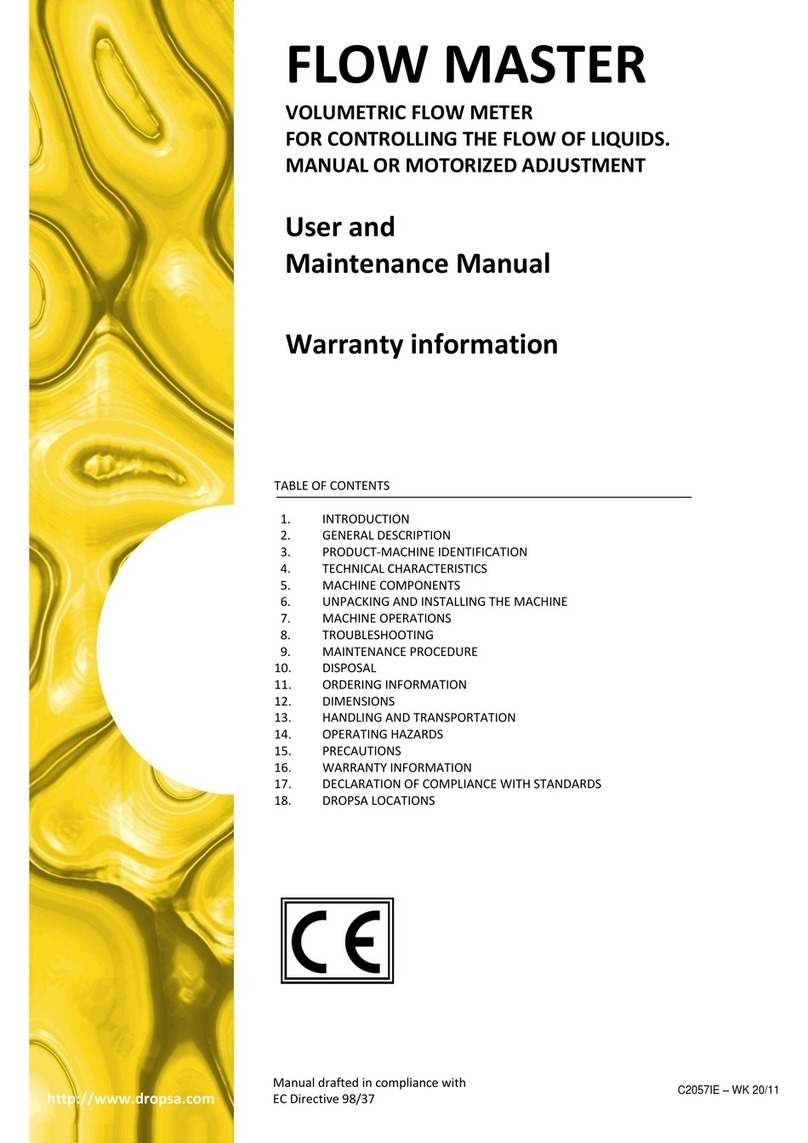
DROPSA
DROPSA Flow master User and maintenance manual
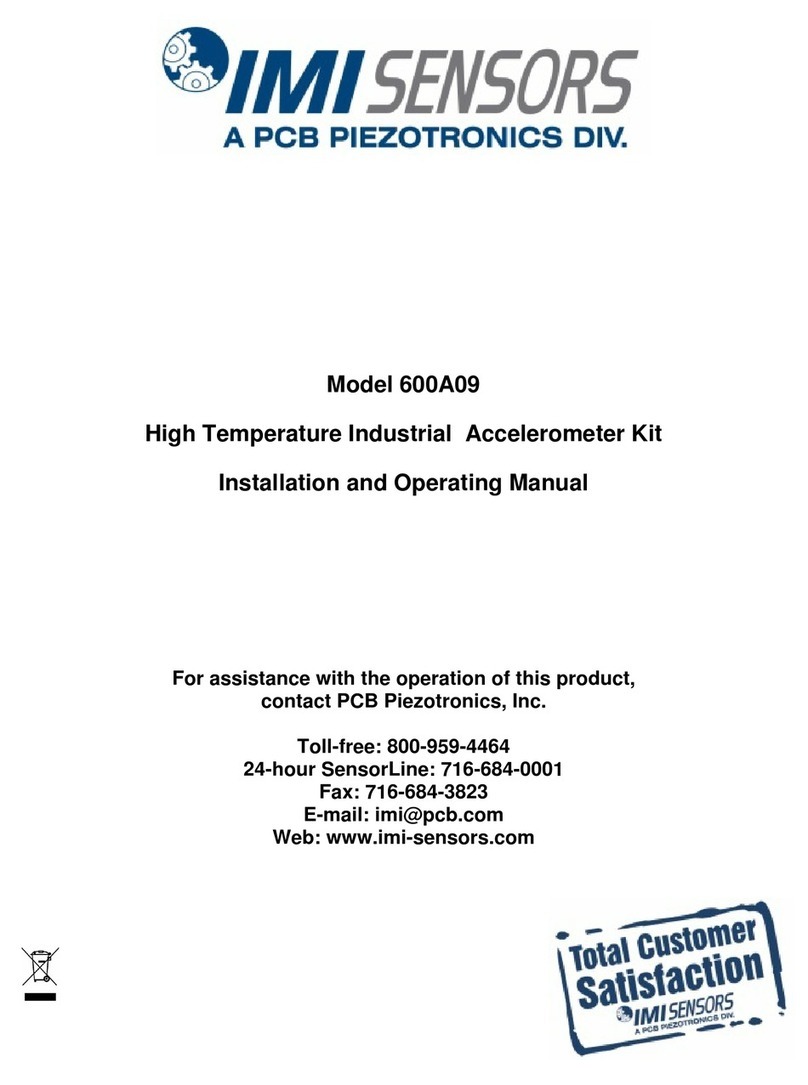
PCB Piezotronics
PCB Piezotronics IMI SENSORS 600A09 Installation and operating manual
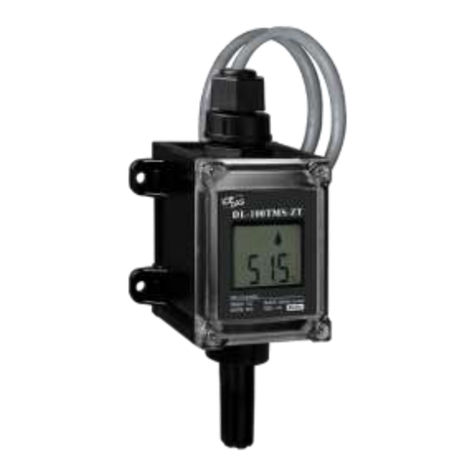
ICP DAS USA
ICP DAS USA DL-100TM-ZT quick start
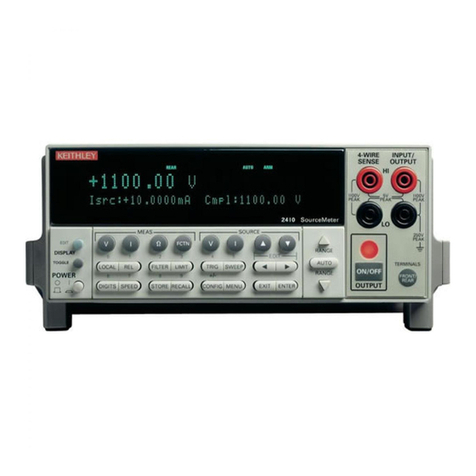
Tektronix
Tektronix Keithley SourceMeter 2410 Service manual
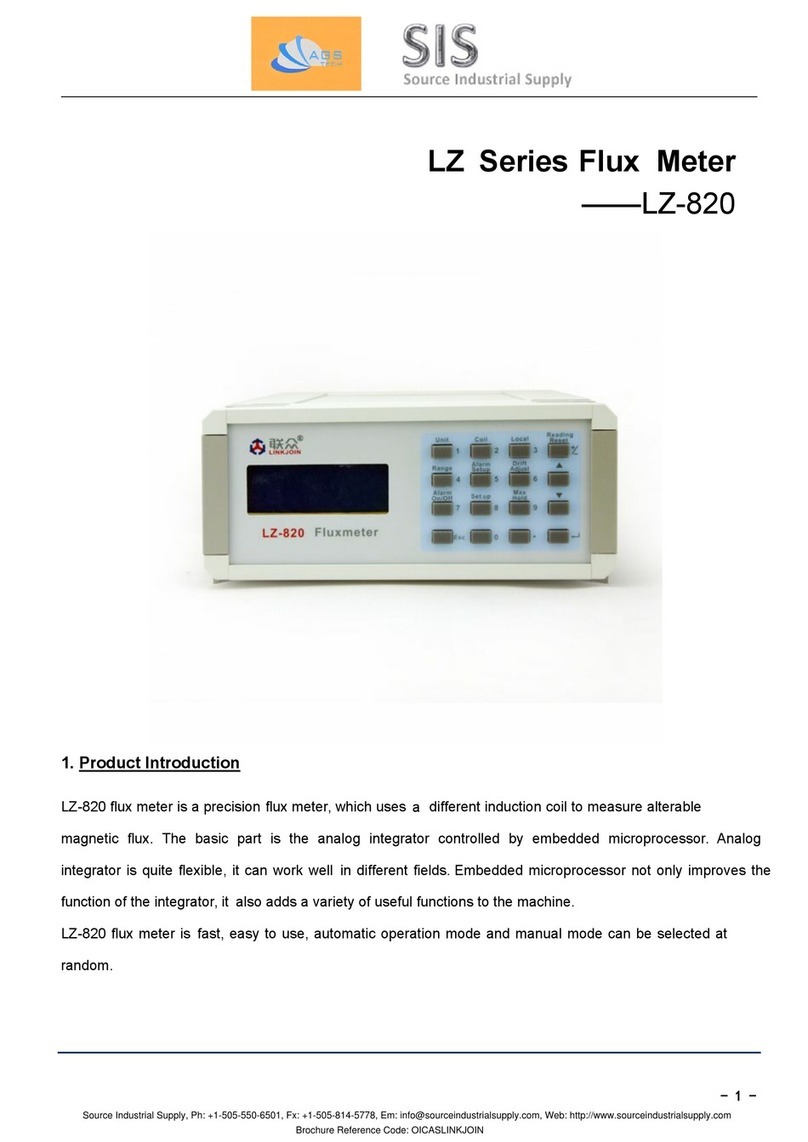
AGSTECH
AGSTECH SIS LZ Series quick start guide
